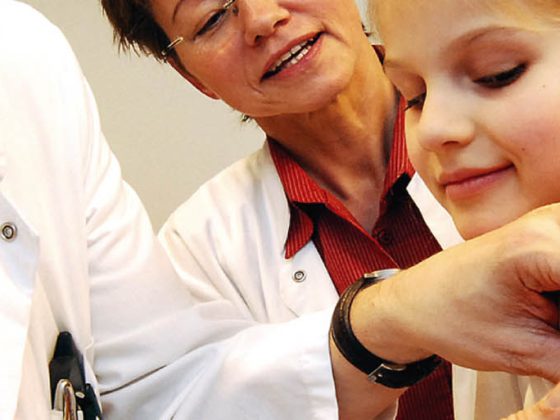At the annual meeting of the German, Austrian and Swiss Societies of Hematology and Medical Oncology (DGHO), various questions regarding the care of patients with Hodgkin’s lymphoma were controversially discussed.What is the status of positron emission tomography, which patients need radiation and how can recurrences and late side effects of therapy best be avoided?
(as) The good news first: Hodgkin’s lymphoma, one of the most common cancers in young adulthood, can now be cured in many cases. With 5-year survival rates of over 80%, Hodgkin’s lymphoma has a good prognosis. The establishment of combination chemotherapy as well as radiotherapy at early stages contributes to the high chances of cure.
The staging of Hodgkin’s lymphoma is based on the modified Ann Arbor classification as well as clinical and laboratory chemistry factors, reported Prof. Thomas Cerny, MD, Chief of Oncology/Hematology at the Cantonal Hospital of St. Gallen. The International Prognostic System (IPS), which takes six factors into account, is used to assess the forecast. Immunohistochemical analyses as well as studies of lymphoma gene expression are also becoming increasingly important for prognosis. Positron emission tomography (PET) is already an integral part of the diagnostic workup. A so-called interim PET after two to four chemotherapy cycles to prove the early response to therapy and the change in the therapy algorithm based on this will optimize therapy in the future so that unnecessary chemotherapy cycles and radiotherapy can be avoided. Conversely, the examination also identifies therapy-refractory tumors at an early stage.
The Hodgkin worlds part at the Atlantic Ocean
Depending on the stage and other risk factors, Hodgkin’s lymphoma is divided into early, intermediate and advanced stages. Patients are treated according to their risk. For patients in early stages, the current standard therapy consists of chemotherapy according to the ABVD regimen (Adriamycin, Bleomycin, Vinblastine, Dacarbazine) followed by radiotherapy. The guidelines currently call for two to three cycles of chemotherapy and 20 Gy of radiation. The use of PET allows for improved prognostic ability and treatment planning.
Whether radiation therapy can be omitted in PET-negative patients is currently under discussion, reported Prof. Andreas Lohri, MD, Kantonsspital Baselland, Liestal, and Basel Medical University Hospital. In particular, there are different views on this side and on the other side of the Atlantic. “The correct therapy is a matter of taste,” Lohri quoted from a recent study published [1]. In this study, patients with early-stage Hodgkin’s lymphoma who had not received radiotherapy had more recurrences than those in the standard treatment group. The study, which was stopped prematurely, does not allow any conclusions to be drawn about overall mortality.
In Germany, radiotherapy remains an indispensable part of Hodgkin’s lymphoma therapy, “but this could also be due to a stubborn attitude of payers regarding the coverage of interim PETs,” said Prof. Peter Borchmann, MD, University Hospital of Cologne, Germany. In Canada, for example, interim PET is obtained after two cycles of chemotherapy, and PET-negative patients receive only two more cycles of ABVD. PET-positive patients complete chemotherapy and also receive radiation. Registry data from British Columbia of 215 early-stage Hodgkin patients had been shown at the 2014 EHA conference in Milan. The data demonstrate identical outcomes for patients with or without radiotherapy. The Canadian experts around Prof. Joseph. M. Connors from Vancouver therefore advocate that the PET findings be included in the treatment decision. In this way, late damage can be avoided that results from radiation but only becomes apparent ten or more years after completion of radiotherapy. Additional studies are underway to determine whether radiation can be omitted after two to three cycles of chemotherapy in PET-negative patients without affecting prognosis.
New therapeutic option for patients in advanced stages
Prof. Borchmann also spoke about the integration of new therapeutics in advanced Hodgkin stages. The escalated therapy regimen BEACOPP (bleomycin, etoposide, adriamycin, cyclophosphamide, procarbazine, prednisolone) is currently considered the standard in German-speaking countries with six therapy cycles. Worldwide, this scheme meets with little acceptance because of the complex requirements as well as the high toxicity, Borchmann said.
The targeted antibody-drug conjugate brentuximab vedotin may be considered as part of a new treatment regimen. This consists of the monoclonal antibody Brentuximab, which specifically targets the CD30 antibody, and the cytostatic drug monomethyl auristatin E (MMAE), which is linked to the antibody by a linker. CD30 is a tumor necrosis factor receptor that is expressed more abundantly on the Reed-Sternberg cells of Hodgkin’s lymphoma and the cells of some non-Hodgkin’s lymphomas. Brentuximab binds specifically to the CD30-bearing cell, introducing the conjugate into the cells. The linker is cleaved by lysosomal enzymes, which releases the cytostatic drug. This destroys the spindle apparatus, thereby inhibiting cell division and causing apoptosis. “You get a high concentration of the cytostatic in the tumor cell without correspondingly severe systemic side effects,” the expert reports. An ongoing trial is testing brentuximab as part of a modified chemotherapy regimen, BrECADD. It contains brentuximab, etoposide, cyclophosphamide, adriamycin, dacarbazine, and dexamethasone.
Source: Advanced Training Hodgkin’s Lymphoma, Annual Meeting of the German, Austrian and Swiss Societies of Hematology and Medical Oncology (DGHO),
October 12, 2014, Hamburg (D)
Literature:
- Raemaekers JM, et al: Omitting radiotherapy in early positron emission tomography-negative stage I/II Hodgkin lymphoma is associated with an increased risk of early relapse: clinical results of the preplanned interim analysis of the randomized EORTC/LYSA/FIL H10 trial. J Clin Oncol 2014 Apr 20; 32(12): 1188-1194.
InFo ONCOLOGY & HEMATOLOGY 2014; 2(10): 29-30.











